Related Research Articles

Ceawlin was a King of Wessex. He may have been the son of Cynric of Wessex and the grandson of Cerdic of Wessex, whom the Anglo-Saxon Chronicle represents as the leader of the first group of Saxons to come to the land which later became Wessex. Ceawlin was active during the last years of the Anglo-Saxon expansion, with little of southern England remaining in the control of the native Britons by the time of his death.

The Kingdom of the West Saxons, also known as the Kingdom of Wessex, was an Anglo-Saxon kingdom in the south of Great Britain, from around 519 until England was unified in 927.

Æthelbald was the King of Mercia, in what is now the English Midlands from 716 until he was killed in 757. Æthelbald was the son of Alweo and thus a grandson of King Eowa. Æthelbald came to the throne after the death of his cousin, King Ceolred, who had driven him into exile. During his long reign, Mercia became the dominant kingdom of the Anglo-Saxons, and recovered the position of pre-eminence it had enjoyed during the strong reigns of Mercian kings Penda and Wulfhere between about 628 and 675.

Wulfhere or Wulfar was King of Mercia from 658 until 675 AD. He was the first Christian king of all of Mercia, though it is not known when or how he converted from Anglo-Saxon paganism. His accession marked the end of Oswiu of Northumbria's overlordship of southern England, and Wulfhere extended his influence over much of that region. His campaigns against the West Saxons led to Mercian control of much of the Thames valley. He conquered the Isle of Wight and the Meon valley and gave them to King Æthelwealh of the South Saxons. He also had influence in Surrey, Essex, and Kent. He married Eormenhild, the daughter of King Eorcenberht of Kent.
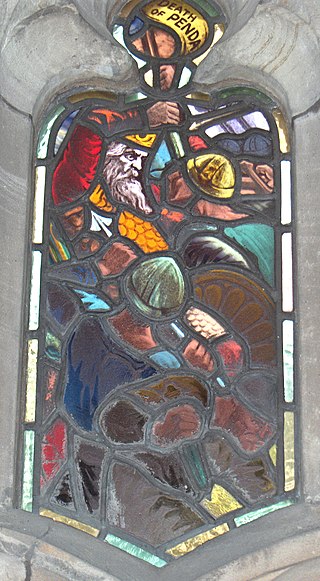
Penda was a 7th-century king of Mercia, the Anglo-Saxon kingdom in what is today the Midlands. A pagan at a time when Christianity was taking hold in many of the Anglo-Saxon kingdoms, Penda took over the Severn Valley in 628 following the Battle of Cirencester before participating in the defeat of the powerful Northumbrian king Edwin at the Battle of Hatfield Chase in 633.
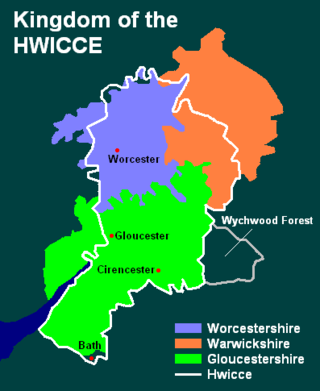
Hwicce was a kingdom in Anglo-Saxon England. According to the Anglo-Saxon Chronicle, the kingdom was established in 577, after the Battle of Deorham. After 628, the kingdom became a client or sub-kingdom of Mercia as a result of the Battle of Cirencester.
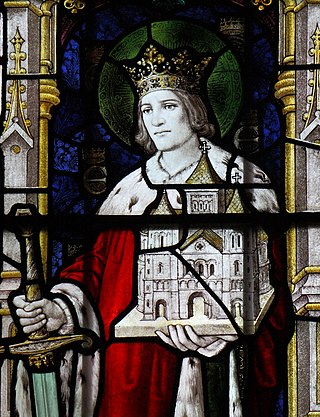
Edwin, also known as Eadwine or Æduinus, was the King of Deira and Bernicia – which later became known as Northumbria – from about 616 until his death. He converted to Christianity and was baptised in 627. After he fell at the Battle of Hatfield Chase, he was venerated as a saint.

Wiglaf was King of Mercia from 827 to 829 and again from 830 until his death. His ancestry is uncertain: the 820s were a period of dynastic conflict within Mercia and the genealogy of several of the kings of this time is unknown. Wigstan, his grandson, was later recorded as a descendant of Penda of Mercia, so it is possible that Wiglaf was descended from Penda, one of the most powerful seventh-century kings of Mercia.
Æthelhere was King of East Anglia from 653 or 654 until his death. He was a member of the ruling Wuffingas dynasty and one of three sons of Eni to rule East Anglia as Christian kings. He was a nephew of Rædwald, who was the first of the Wuffingas of which more than a name is known.

Anna was king of East Anglia from the early 640s until his death. He was a member of the Wuffingas family, the ruling dynasty of the East Angles, and one of the three sons of Eni who ruled the kingdom of East Anglia, succeeding some time after Ecgric was killed in battle by Penda of Mercia. Anna was praised by Bede for his devotion to Christianity and was renowned for the saintliness of his family: his son Jurmin and all his daughters – Seaxburh, Æthelthryth, Æthelburh and possibly a fourth, Wihtburh – were canonised.
Cenwalh, also Cenwealh or Coenwalh, was King of Wessex from c. 642 to c. 645 and from c. 648 until his death, according to the Anglo-Saxon Chronicle, in c. 672.

Cynegils was King of Wessex from c. 611 to c. 642. Cynegils is traditionally considered to have been King of Wessex, even though the kingdoms of the Heptarchy had not yet formed from the patchwork of smaller kingdoms in his lifetime. The later kingdom of Wessex was centred on the counties of Hampshire, Dorset, Somerset and Wiltshire but the evidence of the Anglo-Saxon Chronicle is that the kingdom of Cynegils was located on the upper River Thames, extending into northern Wiltshire and Somerset, southern Gloucestershire and Oxfordshire, and western Berkshire, with Dorchester-on-Thames as one of the major royal sites. This region, probably connected to the early tribal grouping known as the Gewisse, a term used by Bede for the West Saxons, lay on the frontier between the later kingdoms of Wessex and Mercia.
The Gewisse were a tribe or ruling clan of Anglo-Saxon England. Their first location, mentioned in early medieval sources was the upper Thames region, around Dorchester on Thames. However, some scholars suggest that the Gewisse had origins among the ancient Britons, at Cair-Caratauc in Wiltshire. According to Saxon folklore, the Gewisse were the founders of the Kingdom of Wessex.
Centwine was King of Wessex from c. 676 to 685 or 686, although he was perhaps not the only king of the West Saxons at the time.
Ceolwulf was a king of Wessex. At that early date the West Saxons were called the Gewisse, and in his Dictionary of National Biography entry he is given the title "king of the Gewisse". According to the Anglo-Saxon Chronicle he reigned fourteen years and the Annals of St Neots also allot him fourteen years. The West Saxon Genealogical Regnal List gives him a reign of seventeen years.
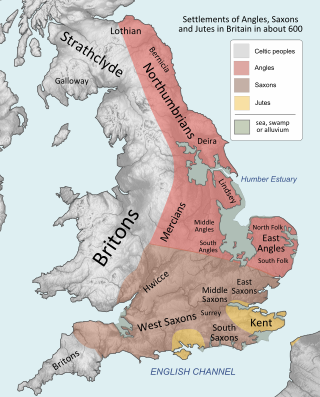
Cwichelm was an Anglo-Saxon king of the Gewisse, a people in the upper Thames area who later created the kingdom of Wessex. He is usually counted among the Kings of Wessex.
The Timeline of conflict in Anglo-Saxon Britain is concerned with the period of history from just before the departure of the Roman Army, in the 4th century, to just after the Norman Conquest in the 11th century.
Cuthwine, born c. 565, was a member of the House of Wessex, the son of King Ceawlin of Wessex. Cuthwine's father Ceawlin was deposed from the throne of Wessex in 592 by his nephew Ceol. Therefore, Cuthwine never inherited the throne. Cuthwine went into exile for many decades, remaining a strong leader of the Saxons and passing on the royal line through his three sons.
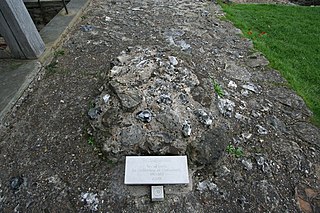
Events from the 7th century in England.
Clemen ap Bledric was a 7th-century King of Dumnonia.
References
- ↑ Swanton, Michael (2000). The Anglo-Saxon Chronicles. London: Phoenix. p. 24.
- ↑ Heighway, Catherine (1996). "Context of the Kemble burials". Transactions Bristol and Gloucestershire Archaeological Society. 114: 14–54.
- ↑ Yorke, Barbara (1990). Kings and Kingdoms of Early Anglo-Saxon England. London: Routledge. p. 136.
51°43′08″N1°58′05″W / 51.719°N 1.968°W